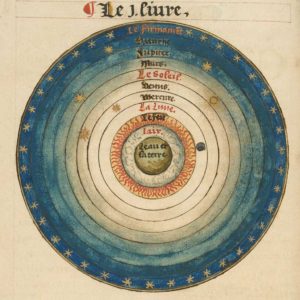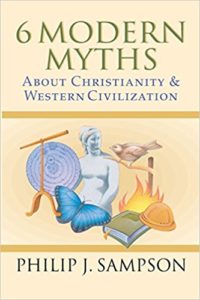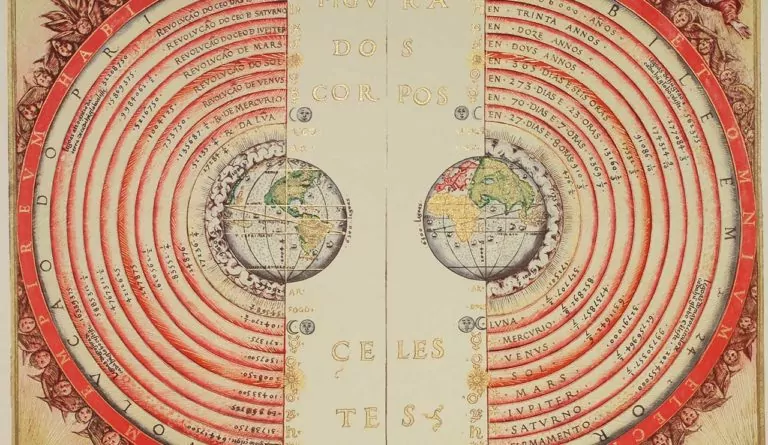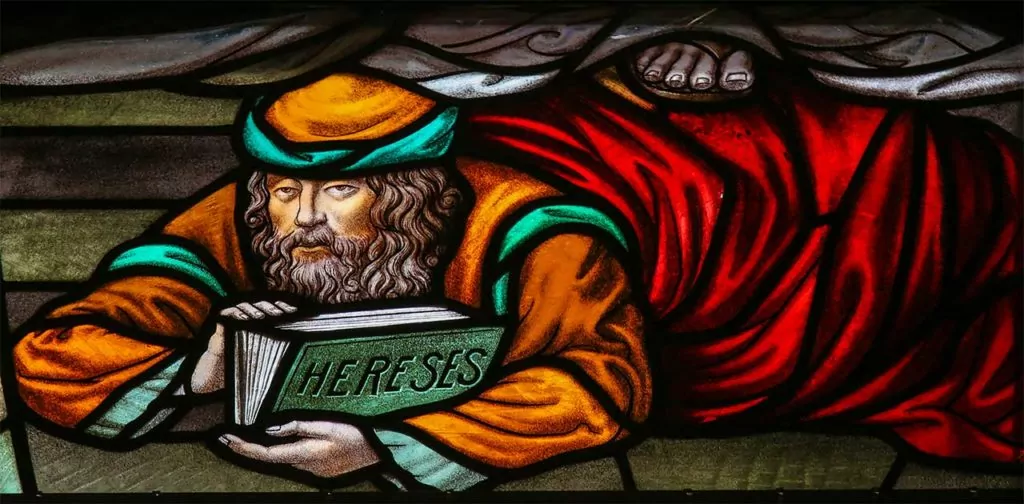As we grow up, receiving instruction at home and at school, we hear many stories that are enduringly imprinted on our minds. Even years later, an adult is often able to recount in detail that vivid scene in the court of King Solomon when he had to rule in the case of the two prostitutes and the one baby, or is able to describe the story of our Lord and the little man Zacchaeus who waited for him in the sycamore-fig tree.
But Scriptural stories are not the only ones imparted to us as we go through the years of our elementary and secondary education. We also hear other “timeless tales,” stories that everyone knows through one source or another. We all know, for example, the story of the flat earth; in the Middle Ages, people believed that the earth was flat and believed that those who went too close to the edge would fall off. It is usually said that this was the official teaching of the church, and was something that restricted any voyages of discovery. The church’s ignorance on this point is considered another aspect of the superstition and intellectual decline that typified the so-called Dark Ages. But though the “villains” of this story, the ignorant ecclesiastical leaders, tried to squelch any exploration, the “hero” Columbus bravely stood against the power of the church and its feared Inquisition, and ventured out onto the high seas – and lived to tell about it.
Other familiar tales from the past could be added to this one, stories that have been told so often and so widely that they attain the status of “myth.”
The purpose of a Myth
When we say “myth,” some might automatically equate this with fiction or fable. But “myth” in a wider sense is a grand story, sometimes true, sometimes not, that explains who we are and how we fit into the universe. A tale told and re-told and perhaps re-enacted on television becomes part of the understanding of our past and of our position today.
In the tale of the flat earth, we are confirmed in our view of the Middle Ages as a period of ignorance and superstition. The church was blindly opposed to scientific progress, while intelligent sailors courageously showed the conventional understanding to be wrong – a well-known story, but one that is not true. Contrary to the details of this tale, historians have long recognized that all educated people of the medieval period knew that the earth was round, and that the account of the church’s suppression of the intrepid Columbus is pure fiction. And yet this myth is still retold, for it nicely contrasts for our minds the rational modern world with the foolish bigotry that preceded it.
It is the place of modern myths that Philip Sampson examines in his book, 6 Modern Myths About Christianity and Western Civilization. After providing the example of the flat earth in his introduction, he looks at other tales that are less innocuous, larger stories that influence the perception of a whole culture – myths that invariably assault Christianity and misrepresent the Scriptures, while lauding humanism and reason.
Sampson has selected six grand stories, the most common value-conveying tales. “[These myths] are the modern mind’s way of communicating its beliefs about the fundamental problems of origins and meaning…A myth presents values and beliefs to us as though they were facts and history.” He observes that myths are not necessarily invented with the conspiratorial intention of obscuring the facts, but are told as reflections of the society that tells them.
The pattern of a Myth
Before beginning his work of showing how several “meaning-carrying” modern myths are truly fictional, Sampson summarizes their general characteristics. The vocabulary connotations in each diverse story are remarkably similar: religion is typically associated with belief, omens, ignorance, superstition, heresy, excommunication, torture, and blood; science is always associated with enlightenment, scholarship, intelligence, open-mindedness, and observation. Each story will also have a plot (usually the struggle of a free-thinking underdog against the ignorant church), a hero (an independent thinker), and a villain (the representative of the powerful church). These stereotyped characteristics already betray the selectivity and bias that underlie each myth.
In the book, six modern myths are first retold, often in the very words of the philosophers and historians that perpetuated these falsehoods and their intended cultural meanings. Sampson then carefully debunks these ideas, telling the real, more complex stories. In addition to Galileo, he tells of:
- Darwin and how his ideas were received in “A Story of Origins”
- Christianity’s impact on the environment in “A Story of Mastery”
- how missionaries treated native peoples in “A Story of Oppression”
- Scripture’s view on the human body in “A Story of Repression”
- the Church’s treatment of witches in “A Story of Persecution”
Let’s join Sampson as he deals with the first of the six myths, Galileo.
Galileo: a story of a hero of science!
The story of Galileo tells us how we fit into the modern world: “We occupy a small planet circling an average sun of one galaxy among many.”
“The Received Version” is probably familiar to our readers: the setting is Renaissance Italy; the plot is the warfare between science and religion; the characters are the plucky Galileo, armed only with a telescope, and the cruel Inquisition and her thumbscrews; the story’s end is that Galileo was tortured, condemned as a heretic, and left to rot in a prison cell, while science floundered.

A geo-centric or “Aristotelian” model of the universe from Oronce Fine’s 1549 book “Le Sphere du Monde.”
The contrast is between the high ground of reason and observation and the cramped cell of religious dogma and truth. As many schoolchildren learn, “The Bible said that everything moves around the earth but Galileo’s observations showed that the earth moves around the sun.” It’s a familiar tale, but as Sampson observes wryly, “The main drawback…is that most of it is untrue.” So what is the truth? Sampson then does some “demythologizing.”
The dominant model of the universe in western Europe up to the late Middle Ages was derived from Aristotle, who reasoned that the heavens, a perfect, unchanging realm, would also be unchangeable in their physical qualities and motion. The earth is at the centre (lowest point) of a universe of concentric spheres, but while the heavenly bodies are ever-perfect, the earth is made of imperfect, changeable matter. This Aristotelian cosmology was essentially the standard view, until the “revolution” of Copernicus (who died twenty years before Galileo was born), who revived the ancient Pythagorean hypothesis that the sun, not the earth, is at the centre of the universe.
A common sub-plot in this “cosmic” myth had to do with how man’s importance was tied to where the earth was placed in the universe. It is usually asserted that the pre-Copernican men had an exaggerated and arrogant sense of human importance and that was why they placed earth as the center of the universe. Then, when it was discovered that we are only “the third rock from the sun,” man was humbled, and simultaneously Scripture was undermined: “If man’s abode was not at the centre of things, how could he be king [of creation]?”
But, as we have seen, the pre-Copernican cosmology was no compliment to earth’s occupants, for in that model the earth is the least important and most transitory place in the universe. Indeed, it was the Copernican system that elevated humanity, lifting the earth to the ranks of perfect heavenly bodies and its inhabitants to heavenly creatures. Far from engendering humility, the end result of the Copernican view was a proud glorification of man and his ability.
Mock the Pope at your peril
The question must be asked, though: Why Galileo as the hero? Why not Copernicus, who had earlier made the key contribution to the “new” cosmology? Sampson notes that Copernicus is not an appropriate character, for he was a canon of the church, he enjoyed the support of the pope, and his book circulated without problem for many years. But Galileo – he was condemned by the church for teaching that the sun is the centre of the universe, and his book confiscated.
The retold modern tale features the persecuted Galileo as scientist and hero. It is said that he invented the telescope, discovered how the earth moves around the sun, conducted his famous experiment on the Leaning Tower of Pisa, and asserted, even in the face of the powerful church, that it is the earth that moves. The truth is, he didn’t invent the telescope, likely didn’t drop cannon balls from the Tower, and didn’t discover the dynamics of the pendulum. He did make major contributions to astronomy, but could not prove that the earth moves around the sun.
Indeed, there was insufficient evidence at Galileo’s time to prove the Copernican view. Copernicus had been hesitant at first to publish his opinions, not for fear of church punishment, as is said, but for fear of being ridiculed by fellow astronomers who still maintained the dominant Aristotelian cosmology. Galileo feared the same rejection, but persistently asserted that the earth literally moves around the sun, “and popularized his views in snappy Italian rather than the arcane Latin of the universities” His book on cosmology became a bestseller.
Galileo’s relations with the (Roman) church at this time were cordial. Most of the church leaders favored his view over Aristotle’s, though they acknowledged that more evidence was needed to establish his case. They judged that Galileo’s view made excellent sense “as a hypothesis.” But Galileo then began to push the envelope; to prove that the earth revolves, he proposed an ingenious but erroneous theory of tides, he argued that comets were a form of optical illusion, and he reinterpreted certain Scripture passages in the light of Copernican reasoning. Then the last straw: he also wrote a “dialogue” in which his view and the Aristotelian view are represented by two characters. In the dialogue, he put a favorite cosmological argument of his friend Pope Urban VIII in the mouth of the conversation’s simpleton. As Sampson notes: “this was not a wise move, and the rest is history.”
The major cause of Galileo’s troubles was then not his view of the earth’s motion as such, but that he had made fun of his Holiness. Sampson notes that today most historians accept that the events surrounding Galileo’s troubles with the church involved complex intrigues of politics and patronage rather than “dogmatic reservations” about Biblical teaching.
The dialogue was confiscated and Galileo summoned to Rome in 1633. But the stories of dank prison cells and torture are modern embellishments; he was detained, and forced to abjure heliocentrism, but he was given his own room and servants, in keeping with his position of favor in the Roman church. In the end he did not die a lonely and broken man, as the Received Version runs, but returned to his home with a church pension to live out his years in peace.
It is said that a larger result of the imagined escapade was that science long floundered under the church’s domination. But Sampson, having dispelled the modern myth of a brave Galileo resisting an ignorant church, now points out another historical fact: rather than warfare between science and religion in this period, there are direct positive connections between them. The Reformation churches, in particular, replaced Aristotelian reasoning (still persistent in the Roman church) with insights from the Bible, and so provided the soil that enabled science to grow.
The relationship between Biblical Christianity and the rise of science is a complex one, but Sampson identifies four basic aspects of it in the Reformation.
- Firstly, there was a restoration of the perspective that nature is created and not divine, and is therefore open to free inquiry and investigation.
- Secondly, the principle of man’s God-given dominion over creation, not domination, was rediscovered.
- Thirdly, reason was properly demoted as dependent on God and not vaunted as a “key” to unlocking God’s secrets, thus encouraging again the study of creation.
- Fourthly, God’s sovereign care for creation was again recognized, with the corollary that certain God-ordained laws in the universe could be discovered through science.
The theme of conflict between religion’s ignorance and science’s enlightenment is at the heart of the Galileo myth. A proper historical study demolishes the oft-repeated tale that lauds free science and mocks repressive religion, and affirms instead the positive framework that Biblical Christianity affords to free investigation.
Postmodern stories
Modernity asserts that reason, facts, and scientific achievements underpin its self-confidence, yet it is persistently told fables that in reality receive the central place in the communication of its worldview. Indeed, it is nothing new that stories are used to pass on modernity’s core beliefs – many societies have used narrative in this way.
The question must be asked though, says Sampson: why do the modern myths have such a negative focus, concerned with the warfare between science and religion, reason and superstition? He suggests that this myopic view represses another story, “one less congenial to the modern mind,” namely that of the damage science has done (e.g., the Chernobyl disaster) and of the brutal reality that confronts the idea of human progress (e.g., two world wars). “Modern myths constantly reinvent a superstitious image of religion in order to brush it aside and with it modernity’s role in oppression.” A well-told story provides an opportunity to neglect the facts and distract attention from corporate shortcoming and guilt.
Postmodernism has recognized the unrealities in modernism’s vision of the world, but the familiar stories have not disappeared. Rather, modern stories are still used, but now selectively, and with strange bedfellows. The modern myths’ presentation of enlightening science is combined with elements of “spirituality” (e.g., the tale of Galileo is accepted by the same person who puts credence in his daily horoscope). Today, tradition and religion are not rejected, but are incorporated with science, in accord with postmodernity’s spirit of eclecticism. And so the falsehood of retold myths will continue to confront us in this postmodern age.
On the book
At first blush one might think that Sampson’s book is only another example of “revisionist history,” where historical events or periods are radically reinterpreted, usually to conform to the historian’s implausibly slanted thesis. But a consideration of the great amount of research carried out by Sampson, also in primary sources, should dispel any fear of revisionism. Indeed, every historian will write from his own perspective and presuppositions, making “objective” historiography impossible. At the same time, we can be honest and careful with the historical evidence that we examine and interpret.
Sampson’s honesty is observable throughout his book. Though depicting the modern myth as invariably characterized by stereotyped features, he resists the temptation to do the same in his retelling. For example, though refuting the image of an ignorant and repressive Christianity, he acknowledges where churches and popes were autocratic; though disputing the extent of the witch hunts (also in Salem, Mass.), he concedes that many women were wrongly killed by Christians for exaggerated charges or suspicions of witchcraft.
6 Modern Myths About Christianity and Western Civilization is relatively short, but bursting with the fruits of Sampson’s research. A slight criticism would be his use of endnotes, which necessitate the use of two bookmarks (which aren’t that scarce, I know) – the interested reader always has to flip to the back of the book to read his often fascinating footnotes, as Sampson digs up varied and obscure sources. The book is not a light read, but it is a stimulating and exciting one, as we accompany the author to the courts of Renaissance Italy, to the jungles of South America, and to the colonial towns of New England. He also provides an abundance of “signposts” for the reader to follow him to his startling conclusions.
Sampson clearly works from a perspective that values the historicity and authority of the Bible. Though he has much to say that is negative about modernity’s credos and their narrative expression, he also makes positive statements about the value of a truly Christian worldview, one that touches all of life and offers a proper approach to all we encounter.
This book would be eminently helpful for any thoughtful Christian reader. Its appeal is broad because the stories Sampson treats are well-known to many of us – familiar stories, but ones whose values and bases are not usually recognized for what they are. With the help of this book we may continue to assert in the world the relevance of the Scriptures for everyday life and may continue to witness to the true freedom that the gospel of grace affords.
Rev. Reuben Bredenhof is pastor of the Mt. Nasura Free Reformed Church in Western Australia. You can find a Dutch translation of this article here. For more on the Galileo myth, see also this excellent article on First Things.











